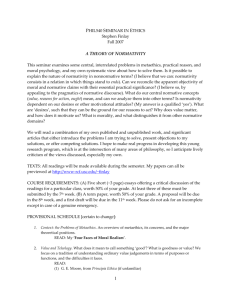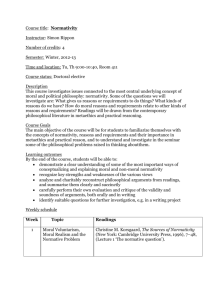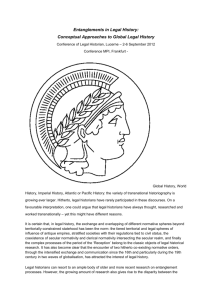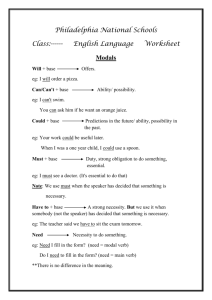Non-doxastic and non-truth-conducive normativity Abstract: I present
advertisement
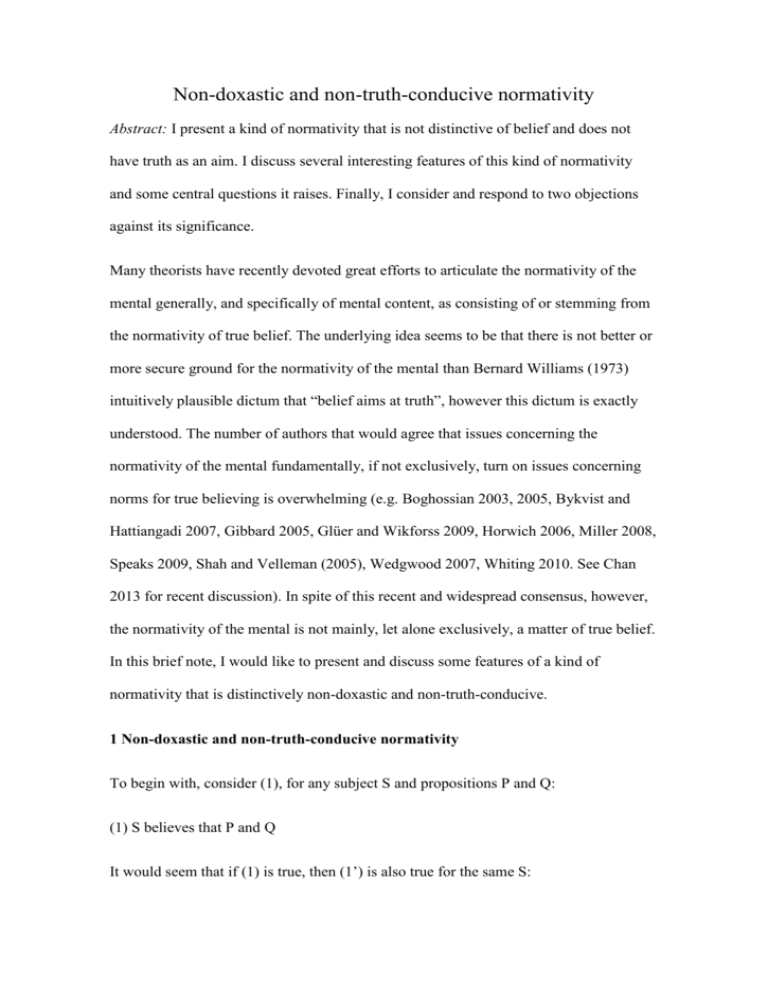
Non-doxastic and non-truth-conducive normativity Abstract: I present a kind of normativity that is not distinctive of belief and does not have truth as an aim. I discuss several interesting features of this kind of normativity and some central questions it raises. Finally, I consider and respond to two objections against its significance. Many theorists have recently devoted great efforts to articulate the normativity of the mental generally, and specifically of mental content, as consisting of or stemming from the normativity of true belief. The underlying idea seems to be that there is not better or more secure ground for the normativity of the mental than Bernard Williams (1973) intuitively plausible dictum that “belief aims at truth”, however this dictum is exactly understood. The number of authors that would agree that issues concerning the normativity of the mental fundamentally, if not exclusively, turn on issues concerning norms for true believing is overwhelming (e.g. Boghossian 2003, 2005, Bykvist and Hattiangadi 2007, Gibbard 2005, Glüer and Wikforss 2009, Horwich 2006, Miller 2008, Speaks 2009, Shah and Velleman (2005), Wedgwood 2007, Whiting 2010. See Chan 2013 for recent discussion). In spite of this recent and widespread consensus, however, the normativity of the mental is not mainly, let alone exclusively, a matter of true belief. In this brief note, I would like to present and discuss some features of a kind of normativity that is distinctively non-doxastic and non-truth-conducive. 1 Non-doxastic and non-truth-conducive normativity To begin with, consider (1), for any subject S and propositions P and Q: (1) S believes that P and Q It would seem that if (1) is true, then (1’) is also true for the same S: (1’) S ought to believe that P The obligation in question seems to be genuine. There are conceivable cases in which (real) subjects may actually believe the conjunctive proposition in (1), and not believe one of the conjuncts, even if they ought to so believe it. The cases may involve involuted contents, lack of attention, lack of understanding of the concept conjunction or sheer irrationality. In so doing, subjects that satisfy (1) but fail to live up to (1’) would be rationally at fault. Their fault may be expressed by saying that they fail to conform to the normativity or obligation expressed by (1’).1 The foregoing point plausibly holds independently of our preferred conception of belief. For instance, it seems to hold independently of whether the belief-attitudes mentioned in (1) and (1’) are understood as occurrent, explicit, tacit or dispositional beliefs. On the other hand, the point, which concerns obligations, could be fleshed out with versions of (1’) that involve permissibility (Whiting 2010), correctness (Wedgwood 2002) or other normative relations. Importantly, the kind of normativity at issue does not (at least directly) concern truth. Granted the truth of (1), the truth of (1’) will still hold even if P were false. The ensuing obligation is an obligation conditional on the belief that P and Q, and not on the truth of that belief. In this sense, the normativity in question is horizontal in Zangwill’s terminology (Zangwill 2010) and regulates attitude-to-attitude relations. This makes a vivid contrast regarding obligations to believe what is true, which establish a 1 These considerations imply that from the fact that (1) is true it does not follow (albeit it is extremely likely) that (1*) is also true: (1*) S believes that P This is arguably not the case for every attitude. For instance, knowledge or perception-based attitudes seem to yield factive (as opposed to normative) entailments. More on this below. paradigmatic attitude-to-world relation. Given the truth of (1), (1’) holds independently of the truth of what is believed. Remarkably too, even if (1) and (1’) plainly involve beliefs or belief-transitions, the kind of normativity signaled is clearly non-doxastic in that it equally applies to many non-doxastic attitudes. Consider the following pairs: (2) S desires that P & Q (2’) S ought to desire that P (3) S hopes that P & Q (3’) S ought to hope that P (4) S speculates that P & Q (4’) S ought to speculate that P These cases are structurally identical to the previous one. If we assume that (2), (3), and (4) are true, then (2’), (3’) and (4’) all express plausibly correct normative statements for the same subjects. It follows from this that (1) and (1’) would be only an instance of a general form of non-doxastic or not specifically doxastic normativity, one that affects indefinitely many different attitudes and attitude transitions. Let us express the target normative relations more explicitly in terms of conditional statements from now on. The normativity relating (1) and (1’) can be stated thus as in (1’’): (1’’) If S believes that P & Q, then S ought to believe that P Note that this result has nothing to do with the fact that the examples concern a particular logical concept, such as conjunction. The same kind of considerations apply for attitude transitions involving other logical connectives such as, negation or the conditional: (5) If S believes that if P then Q, and S believes that P, then S ought to believe that Q (6) If S believes that P, S ought not believe not P Again, (5) and (6) seem correct and have nothing particular to do with beliefs. Analogous normative principles hold for suppositions, desires, hopes, intentions, anticipations and many other cognitive or volitive attitudes. The kind of normativity at issue may also be illustrated in terms of non-logical concepts: (7) If S presumes that a is a bachelor, then S ought to presume that a is an unmarried man (8) If S is sad that x is square, then S ought to be sad that x is square-shaped (9) If S intends that x is red, then S ought to intend that x is red-coloured (7), (8) and (9) all involve plausible normative principles for non-logical concepts which, again, are non-doxastic or not specifically doxastic. Significantly enough, the target normativity affects equally attitudes that may be considered at first sight to have little or no normative force. Consider the following: (10) If S daydreams that P & Q, then S ought to daydream that P (11) If S entertains that P & Q, then S ought to entertain that P (12) If S imagines that P & Q, then S ought to imagine that P Contrary to some explicit claims in the literature to the effect that these attitudes do not involve any normativity (Boghossian 2005: 213; Speaks 2009: 410), (10), (11) and (12) have an initial plausibility. Finally, there are arguably several possible grounds for the statement and articulation of the here presented kind of normativity. These considerations are, to be sure, in the vicinity of epistemic (Hintikka 1962). The target principles may also be justified by appeal to the inferential role characterizations of the concepts figuring in the relevant transitions (Peacocke 1992, Wedgwood 2007). From the point of view of the discussion of normativity, however, it also seems to be a legitimate option to simply take the principles as given, granted their intuitive plausibility. These considerations suggest that the kind of normativity just highlighted constitutes an independent field of study which may be aided by the developments belonging to several other fields. 2 Attitude normativity As noted, the normativity is non-doxastic in the sense that it is not distinctive of beliefs, and it is non-truth-conducive in the sense that it does not has truth as an aim–i.e. it may concern obligations involving false beliefs. The aim of the normativity could be preliminarily stated in terms of “content preservation” or “content coherence”. The principles may be taken to express that it follows from the natures of the contents figuring in the attitudinal state that one is obliged to perform in thought or to find compelling certain transitions. If true, this would suggest that the common explanatory factor underlying the (structurally identical) normativity of so many different attitudes and attitude transitions is mental content, and in particular, the content of the concepts figuring in the transitions. However, mental content is very likely not the whole story about this sort of normativity. As several authors have independently pointed out, attitudinal normativity is also crucial (Zangwill 2010, McCullagh 2005, Speaks 2009). Let us focus on (13): (13) If S rejects P & Q, then S ought to reject P* (13) is clearly not correct: one may reject P & Q because one rejects Q without thereby having to reject P. Note that this is hardly an incidental case. It affects indefinitely many negative or non-assertoric attitudes such as disbelief, denial, disagreement, regret, hate, dislike, etc. This result suggests that part of the normativity associated with a given content comes from the positive or negative character of the attitude and not, or not only, from the relevant propositional content or content-constituents. One may object to this conclusion that the inferential effect induced by this class of negative attitudes may be captured wholly in terms of positive attitudes with suitable negative contents. However, this is quite certainly not the case. For instance, it is not a good idea to take (13) to be equivalent to (13’) (13’) If S accepts that not (P & Q), then S ought to accept that not P* (13’) is, like (13), not correct and for what is a very similar reason, namely, that one may accept not (P & Q) on the basis that one accepts not Q, and not on the basis that one accepts not P. But it does not seem correct to say, as our imagined objector would suggest, that rejecting P is tantamount to accepting not P from a normative point of view. To show why we only need to consider a straightforward example: (13’’) If S accepts that not P, S ought not accept that P (13’’’) If S rejects that P, S ought not reject that not P* If the normative import of these principles could be wholly captured in terms of suitably modified (positive/negative) contents when considering rejection and acceptance, (13’’) and (13’’’) should be two ways of expressing the same normative relation. However, whereas (13’’) is most plausible, (13’’’) is not. It seems rationally permitted that one rejects both P and not P (e.g. one may reject that the glass is empty and that the glass is not empty, because there is no glass in sight). If this is correct, the normativity of rejection is not fully captured by the normativity of acceptance of negative contents. Generally, every attitude or kind of attitude has a distinctive normative import not easily captured wholly in terms of contents. For instance, (14) and (14’) seem clearly incorrect while (14’’) seems to be just right. (14) If S believes that P, S ought to believe that not P* (14’) If S rejects that P, S ought reject that not P* (14’’) If S doubts that P, S ought to doubt that not P Strikingly (14’’) is plausible because if one does not doubt (say, believes or rejects) that not P then it seems irrational that one doubts P. The same would go for other attitudes such as being indifferent or agnostic. These neutral attitudes still have some distinctive normativity. As it happens, other attitudes seem to involve no normativity of the sort here highlighted because they are factive or purely descriptive: (15) If S knows that P & Q, then S ought to know that P* (16) If S sees that P & Q, then S ought to see that P* (17) If S feels that P & Q, then S ought to feel that P* (15), (16) and (17) are intuitively incorrect. These normative claims are implausible because the antecedent already implies fulfillment of the alleged obligation figuring in the consequent: from the fact that S knows or perceives P and Q, it follows that S knows or perceives that P. It does not make sense to have obligations one cannot fail to satisfy (Glüer and Wikforss 2009, Bykvist and Hattiangadi 2013). If the foregoing analysis is correct, it would show that the possession of attitudinal state with propositional content is not a sufficient condition for the existence of genuine normative principles. At least some propositional attitudes should be considered as free of any normative import. For simplicity’s sake, so far I have only introduced principles that concern a single type of attitude but the here discussed kind of normativity also concerns different attitude types. Consider the following as an illustration: (18) If S perceives that P, S ought to believe that P (19) If S desires that P, S ought to intend that P (20) If S believes that P, S ought not expect that not P These principles seem straightforwardly correct and support the view that the target normativity cannot stem only from propositional contents: The same propositional content P yields different obligations depending on the attitude in which it is embedded. This is so even if the attitude in question is factive in the sense introduced above, as (18) illustrates. From all this it seems to follow that attitude normativity or the normativity found in attitudinal states is more involved than we might expect. At a minimum, it is the result of the joint combination of complex attitude-effects and content-effects. 3 Normative scope To all appearances, non-doxastic normativity is of a wide scope. Our notation may be improved to capture this fact. Consider (21) and (21’): (21) S ought to (believe that P), if S believes that P & Q (21’) S ought to (believe that P, if S believes that P & Q) As Broome (1999, 2007) has pointed out, (21) and (21’) are not equivalent. The former but not the latter express a detachable obligation. According to (21), whenever one actually believes that P and Q, one has an obligation to have a particular belief-attitude. The relevant obligation in (21) has narrow scope. However, the normativity so far considered seems to be better captured by non-detachable conditionals such as (21’). In the first place, the obligations in question are not inevitable obligations to believe or have an attitude that such and such, granted that certain conditions obtain, whatever those conditions might be. The target requirements are not requirements that one must live up to, granted some sufficient condition obtains, as the narrow scope reading of (21) expresses. By contrast, the principles pick out consistency requirements among one’s beliefs and attitudes. One may live up to those requirements by altering one’s attitudes, something that is allowed in the case of the wide scope reading of (21’). For instance, let us suppose that one has both the belief that P and Q and the belief that not P. Fulfilling our obligations in the case of (21) would automatically force one to have contradictory beliefs. However, the case of (21’) is intuitively different. Satisfying our obligation in the case of (21’) may result in the critical revision of our beliefs. Secondly, the wide scope reading guarantees that the target obligations affect the attitude transitions or relations and not exactly the attitudes themselves. What the principle regulates is therefore what subjects ought to do, attitudinally speaking, in the light of their attitudes and not directly the conditions for having an attitude-obligation or obligation to have a particular attitude. There are reasons to be suspicious about the notion of an attitude obligation, that is to say, the notion of an obligation to have such and such an attitude, as it appears in the narrow scope reading. On the one hand, it seems to be committed to doxastic voluntarism, or the thesis that subjects can have beliefs at will. If we are subject to obligations regarding particular beliefs, then it seems to follow that one can decide to have or not to have those particular beliefs. Nothing of the sort follows from the wide scope reading. For instance, (21’) requires only that we can decide to revise the consistency relations of our beliefs and not directly decide to have or cease to have those very attitudes. On the other hand, the notion of attitude obligation leads to an undesirable regress of motivations (Glüer and Wikforss 2009): motivations to respect a certain obligation require having certain attitudes towards the obligation. A regress ensues if one opens the door to attitude-involving motivations for respecting obligations to have a given attitude. However, if the normativity in question is of a wide scope, as in (21’), this problem is avoided because there is no obligation to have an attitude in the first place but, quite differently, obligations to respect certain transitions and relations among one’s attitudes. 4 Two objections One may try to downplay the significance of the above considerations. First, one may conjecture that the kind of normativity at issue is not really non-doxastic because it is a kind of normativity that ultimately derives from belief normativity. On this account, belief would have a prevalent role in the psychological economy of subjects so that the normativity concerning other non-doxastic attitudes would be derivative. This point may be argued by appeal to the plausible conceptual primacy of belief: possession of non-doxastic attitudes, such as desire, would seem to presuppose possession of beliefs but not the other way around (Boghossian 2003, 2005). The appeal to the conceptual primacy of belief is not free of controversy (cf. Miller 2008). Nonetheless, we may grant the view for the sake of the argument. Note that the considerations of our imagined objector would only go through if the alleged conceptual primacy of belief ultimately resulted in a reduction of nondoxastic normativity to doxastic normativity. Otherwise the significance of the kind of non-doxastic normative principles would not be undermined, even if one grants the conceptual primacy of belief in the sense specified above. But there seems to be general and specific normative results that would tell against the viability of any such reduction. First, there are general normative features that suggest that belief is fundamentally different from non-doxastic attitudes. For instance, it would seem that it is only for belief and belief-related attitudes that, in Searle’s celebrated terms, there is a ‘mind-to-world’ direction of fit and that this would make a substantial normative difference regarding desires and volitive attitudes with a ‘world-to-mind’ direction of fit. On this account, beliefs and the like, but not desires and the like, would involve requirements to fit or accurately represent the world. Other attitudes, such as imagination or enterntainment seem not to involve direction of fit at all. These are general aspects that would yield radically different kinds of normativity for each attitude type. These differences would presumably prevent reduction. On the other hand, the previous discussion has already encountered specific normative principles for negative and neutral attitudes. For instance, whereas S ought not to believe that not P, if S believes P (viz. (6)), it would seem that S may reject that P and that not P (viz. (13’’’)), and, furthermore, that one ought to doubt not P if one doubts P (viz. (14’’)). How could this different entailments be fully derived from the normativity of belief? These are quite specific pieces of evidence for the irreducibility of non-doxastic to doxastic normativity. Another possible objection trying to resist the importance of the preceding discussion may focus on the non-truth-conducive character of the normative principles so far discussed. For it is clear–our contender may argue–that many of the normative relations expressed in the foregoing principles can be seen as a result of the fact that the relevant transitions are truth-preserving. For instance, the correctness of (1’’) may be seen as expressing the elimination rule for the connective: (1’’) If S believes that P & Q, then S ought to believe that P2 If this is correct, the obligation in (1’’) would stem from the truth-preserving character of the transition, and in that sense, be truth-conducive after all. I agree that in this particular case, and in many others as well, the relevant obligations can be seen as a stemming from the truth-preserving character of the transitions and, to that extent, be considered as truth-related. All the same, please note, the target normative principles go well beyond principles that have truth as an aim and thus I dispute that these principles are relevantly truth-conducive. For one thing, the target principles actually result in subjects possibly having plenty of obligations involving false beliefs, and even necessarily false beliefs. The only thing needed, for a subject to have such an obligation, is that, for instance, the subject 2 Cf. Peacocke (1992). actually believes false propositions as part of a given conjunctive thought. The subject would not be rationally at fault regarding this kind of normativity on this score. For another thing, the normativity in question concerns indefinitely many principles with attitudes which are simply insensitive to truth. This seems to be the case of ‘world-to-mind’ attitudes (desires, preferences, hopes…) generally, and attitudes such as entertaining or imagining. For instance, one may desire what is false, and that seems to be indeed the general case. This is also one of the chief virtues of imaginings: to imagine what is false or even impossible. Whatever the aim of the principles involving these attitudes exactly is, it should be clear that it is not truth, and indeed not truth as it figures in our putative obligations to believe what is true. Conclusion In this piece, I have introduced a kind of mental normativity that is not specifically doxastic or truth-conducive. It falls distinctively apart from obligations to believe or to have any attitude regarding what is true. Although several theories may be used to undergird or elaborate this kind of normativity, intuition seems to suffice in order to acknowledge that it exists and is worth exploring. Although structurally analogous principles from one attitude type to another attitude type encourage the view that the source of this normativity is mental content, I have argued that it is fundamentally also attitudinal. I have defended that the correct interpretation of the target principles reads them as having wide scope. Finally, I have defended the significance of this kind of normativity from skeptical considerations regarding their non-doxastic and non-truth-conducive character. Further investigation is very much needed in order to address the rest of questions that this kind of normativity raises. References Boghossian, P.A. (2003). The normativity of content. Philosophical Issues, 13(1), 3145. Boghossian, P.A. (2005). Is meaning normative? In A. Beckermann and C. Nimtz (Ed.), Philosophy-Scienc-Scientific Philosophy (pp. 205-218). Paderborn: Mentis. Broome, J. (1999). Normative requirements. Ratio, 12(4), 398-419. Broome, J. (2007). Wide or narrow scope? Mind, 116(462), 359-370. Bykvist, K., & Hattiangadi, A. (2007). Does thought imply ought? Analysis, 67(4), 277285. Bykvist, K., & Hattiangadi, A. (2013). Belief, Truth, and Blindspots. In T. Chan (Ed.), The aim of belief. (Chap. 6). Oxford: Oxford University Press. Chan, T. (2013). The aim of belief. Oxford: Oxford University Press. Gibbard, A. (2005). Truth and correct belief. Philosophical Issues, 15(1), 338-350. Glüer, K., & Wikforss, A. (2009). Against content normativity. Mind, 118(469), 31-70. Hintikka, J. (1962). Knowledge and belief: An introduction to the logic of the two notions. Cornell: Cornell University Press. Horwich, P. (2006). The value of truth. Nous, 40(2), 347-360. McCullagh, M. (2005). Motivating inferentialism. Southwest Philosophy Review, 21(1), 77-84. Miller, A. (2008). Thoughts, oughts and the conceptual primacy of belief. Analysis, 68(3), 234-238. Peacocke, C. (1992). A study of concepts. Oxford: Oxford University Press. Shah N. and Velleman, D. J. (2005). Doxastic deliberation. Philosophical Review, 114(4): 497-534. Speaks, J. (2009). The normativity of content and ‘the Frege point’. European Journal of Philosophy, 17(3), 405-415. Wedgwood, R. (2002). The aim of belief. Philosophical Perspectives, 16(s16), 267-297. Wedgwood, R. (2007). The nature of normativity. Oxford: Oxford University Press. Whiting, D. (2010). Should I believe the truth? Dialectica, 64(2), 213-224. Williams, B. (1973). Problems of the self. Cambridge: Cambridge University Press. Zangwill, N. (2010). Normativity and the metaphysics of mind. Australasian Journal of Philosophy, 88(1), 21-39.
